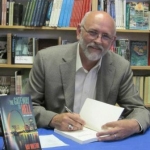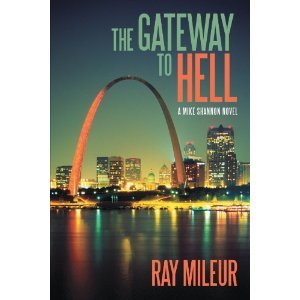Author: Ray Mileur
Title: The Gateway to Hell
Publisher: iUniverse
ISBN: 978-1-47590-077-4
Pages: 260, Paperback/Kindle
Genre: Mystery
Author interview with Ray Mileur
 Author Interview with Ray Mileur
Author Interview with Ray Mileur
The Gateway to Hell
Interviewed by: James Sadler, Pacific Book Review
Today we have the pleasure of being with Ray Mileur, author of The Gateway to Hell. Thank you Ray for taking your time to join us.
RM: Thank you. It’s great to be with you James.
PBR: Was the police corruption in your novel inspired by any true events that took place in St. Louis? If so, what were the events?
RM: The police corruption case was actually inspired by events in New York City, including the theft of the drugs from the famous French Connection case. In that case, over a three year period, heroin and cocaine was checked out of the police evidence room five times and then eventually stolen, and replaced with a flour cornstarch substance. A prime suspect, who was a police officer was eventually murdered. The case is still open today.
The death of Detective Steve Holland, was actually similar to the execution of a police detective in the 1980s, who was murdered in Jacksonville, North Carolina, his body dumped on the steps of the courthouse. At that time, I was in the Marines, assigned to JAG, attached to the State of North Carolina. My office was only about a block from where the body was found. I did have some contact with the investigators and some suspects. One suspect was actually arrested in my office, but I was not involved in the homicide investigation.
PBR: Similarly, are the mob figures, particularly the leaders, based on any particular real life characters? If so, who were they?
RM: As a private investigator I did have some contact with a couple of members of the St. Louis crime family, getting caught somewhere, where I wasn’t wanted and I managed to bluffed my way out of a couple of tough situations. In the real world, I prefer bluffing over shooting. In any potential dangerous or deadly situation, you are constantly evaluating the potential legal consequences, both criminal and civil, before you act. I will say this, Mike Shannon has killed more men than me, but not more than I wanted to.
Salvatore Salerno, the St. Louis Don, was based in large part on the life of Joseph Bonanno, the onetime boss of bosses, who was known in the inner circle of the Five Families of New York, as the Father of Fathers. He was a Sicilian, who came to American in the prohibition era and brought with him the Sicilian traditions, in which loyalty, honor and family ties were paramount. He strongly opposed the New York Families getting involved in the drug trafficking.
PBR: Is there a real life CIA squad that Sabre 6 is based upon or modeled after? How did you come up with the idea for Sabre 6?
RM: There have been similar off the book para-military units used by the Company. My contact with the CIA has been limited, as one might suspect. I am very close to one former station chief and did have some contact with a former CIA agent, my FBI roommate, and some of the parties involved in the Valeria Plane case.
The term Sabre 6, actually came from the name of a security team I was part of, while protecting an Iranian millionaire in the states, during the 444 day Iranian Hostage situation in the American Tehran Embassy from November 1979 to January 1981. If you recall the hostages were released just minutes after President Reagan was sworn into office. Eventually the Sabre security unit disbanded.
In addition, the term Sabre, also represents the Sword of Justice, its rapier designed to deliver a deadly blow. A good description of team and its purpose.
PBR: This is more of an observation, than a question. At times, the timelines you mention don’t seem to correspond or add up correctly. For example, on page 137 it states: “Shannon had been a Marine for six years and a cop for eleven.” He enlisted at age 18, so he was out at age 24. And then, presumably, retired as a cop around age 35. On page 153, Shannon reminds Carol that she married him when he was a marine. At the time of the story, Shannon is almost 50 (p. 57).
But it appears he and Carol had only been together only for a little over ten years, as on page 65 it reads: “She hugged him and he felt her breasts pressing against his bruised chest. He winced, but she felt so damn good back in his arms that he’d bear the pain. He’d been doing that for over ten years: living with the torment she brought into his life because she felt so good.”
PBR: It seems that if they married while he was in the marines and he is now around 50, they were together much longer than 10 years. I think there are similar issues with some of the other timelines in the story regarding his relationships and when he worked for whom. So are my deductions correct or perhaps there is some ambiguity in these details?
RM: Once a Marine, Always a Marine. The timeline with Carol, is closely associated with my personal timeline in a very similar, on again, off again relationship. Shannon did spend six years on active duty in the Marines, and continued to serve as a member of the United States Marine Corps Reserve (USMCR). Sometimes serving in an active role, other times he was inactive and assigned to the IRR (Individual Ready Reserves), this all while at the same time serving with the St. Louis Police Department. This is very common, for example, my own military career ran concurrent for the most of my life with my civilian career. It can become confusing when you are wearing more than one hat or one uniform at the same time. Shannon because of his unique skills often served in a dual role for the Marines, assigned to participate in Black Ops and other off the book assignments. Those assignments can be very frustrating, because you are a still a Marine, you just won’t look like one, or act like one in many cases. Shannon held onto his association with the Marines for so long, because like me, it was the only place he felt like he ever belonged.
PBR: I was a little confused about the opening chapter. It seemed to foreshadow a scene that would be repeated later in the book—I thought it was alluding to the assassins, corrupt police officers, and others hunting him—but it doesn’t reoccur later in the book. Does the opening chapter take place before the other chapters, or was it intended to fall into the storyline elsewhere?
RM: The opening scene, “They wanted him dead,” referred to the Escobar Drug Cartel that had already placed a price on his head by the time he had returned to St. Louis. Shannon’s concern was now that his covert identity had been exposed, that he was going to be an easy target. If someone, really wants you dead, there isn’t much you can do about it. In the back of his mind, he doesn’t even trust the government. He suspected that the leak of his identity might be politically motivated, which could make Shannon’s life expendable. It wouldn’t be the first time. When the rogue CIA hitman, Anthony Morreti, aka the Sandman, arrived in St. Louis, Shannon assumed that he might be there to take him out. Shannon just wasn’t sure who was going to pick up the tab for Morreti to kill him. It was Morreti who actually took out the two mobsters in the warehouse, which had been assigned to kill Shannon after Morreti had eliminated Ryan Horn.
Once it’s revealed to Shannon, that he and Morreti have both been working on the same side, the same team, and that the mob has been recruiting and financing Black Ops for the White House. Shannon has reason to believe, that there were those in Washington, that wasn’t going to just let him walk away from Sabre 6 alive. There is still the question, as to who leaked his identity and why? Even in the end of the book, he’s still looking over his shoulder, because the bottom line is, they still want him dead. The question as always is, who is they? You’ll have to read the next book in the series, “Naked Terror”, because it isn’t over.
PBR: You make excellent use of your knowledge of St. Louis. Do all of the bars and restaurants mentioned actually exist, or are they fictional?
RM: My detective agency was in St. Peters, Missouri, just west of St. Louis. Over the years I spent a lot of time in the city. The bars and restaurants in the book are very real, some of them like Elshers, (On the Landing), are no longer there, though their old sign is still hanging on the building.
Other places in the book like Jake’s and Charlie Gitto’s (On the Hill), are very popular restaurants. Then the places like Soulard, Forrest Park, and the Kodner Gallery are real as well. I wanted to create a character and a setting for the Mike Shannon series, that would be different than the typical, New York, Boston, or LA, private detective novels that everyone is so use to reading.
In a small way, I’d like for the Shannon series to continue to promote Laclede’s Landing and the City of St. Louis, perhaps even serve as a guide to the best restaurants, hotels, and attractions. I see some potential marketing opportunities there and I also thought it might be interesting to have readers someday, eat a Jakes (On the Landing), and sat at the table in balcony and say “hey, this is Mike Shannon’s table.”
PBR: This has all been very interesting and we wish you the best of success with your book. Thank you again for tanking some time to be with us today.
RM: Thank you, James. Next time you’re in St. Louis, stop by Jakes and we’ll have a steak and sit at Shannon’s table. If I’m still around.



Follow Us